As an Amazon Associate, we earn from qualifying purchases with no additional costs for you.
There are so many knife steels available that it becomes confusing to choose which is the best steel for a particular knife. Why do knifemakers choose different steel types for different knives rather than a single steel type for all knives?
The best steel for a knife is the steel that has the characteristics allowing the knife to perform exceptionally for its intended purpose. There is no one-size-fits-all steel for all knife types making it important to choose a knife made from the best steel possible for the job.
Each type of steel has different characteristics due to its composition and the way the steel is hardened. These steel characteristics make certain steel types more suitable for different knife types and some steel unsuitable for the knife. The knife’s purpose will be the critical factor in determining the best steel for the knife. We have detailed the best steel type for different knife types to assist in deciding what combination will be best for your knives.
If you are looking for good knives made from high-quality steel, you will find an excellent option here (Amazon link)

What Is The Best Steel For Knife (In General): TOP 6 Knife Steels
The huge selection of steel for knife making can make choosing a knife a mindboggling choice when considering the best steel for the job.
Essentially, knife steels are divided into three main categories: carbon steel, stainless steel, and steels that exhibit some qualities from each of these two steel types.
Some extremely hard and durable steels have been manufactured in modern times, but the complexity of manufacturing these super-steels makes them extremely expensive and impractical for knife-making.
There are 6 top knife steels for knifemaking, which will fall into one of the categories mentioned above.
1. Japanese Carbon Steel For Knifemaking
Japanese carbon steels are renowned for their hardness and the high level of sharpness they can attain. This is the primary steel used in traditional Japanese kitchen knives for its lightweight and extremely sharp edge characteristics.
There are different grades of Japanese carbon steel: Blue Paper steel, White Paper steel, and Yellow Paper steel. The color reference is not related to the steel color but rather the color of the paper the steel is wrapped with to distinguish the different steel types.
Blue Paper steel, or Aogami, is the hardest, with better toughness and edge retention than the other steel types. This steel is the most expensive of the Japanese carbon steel types.
White Paper steel, or Shirogami, has slightly less carbon content than Blue Paper steel, resulting in a lower hardness level and more brittle steel. It has good edge retention and can be sharpened to a very fine edge. White Paper steel is not as expensive as Blue Paper steel.
Yellow Paper steel of Kigami is the lowest quality of the Japanese carbon steel but is still good knifemaking steel for mid-range kitchen knives. Even though it is of lower quality than the Blue and White Paper steel, it can still be hardened to above 60HRC.
2. Spring Steel For Knives
Spring steel is a popular knifemaking steel due to its high level of toughness and wear resistance. The “springiness” of the steel makes it resistant to impact and blade deformation, and steel fatigue.
The most popular spring steel for knifemaking and for sword making is 5160 because the heat treating of the steel is relatively easy and cost-effective, and less precision is required with the temperatures needed.
Spring steel has a high carbon content, making it hard steel that can be heat treated and tempered to a maximum of 63HRC hardness.
Spring steel is considered a form of carbon steel and does not have sufficient chromium and other metals that promote stain and rust resistance.
3. Tool Steel For Knife Making
Tool steels are very popular among custom knifemakers due to the durability of the steel and how easily the steel can be heat treated.
O1-Tool steel is one of the most popular tool steels for knifemaking, with D2-Tool steel coming in a close second. These steels can be forged and have very good wear resistance and top-notch edge retention.
Tool steel is high carbon steel, exhibiting low resistance to staining and rust but better stain resistance properties than Japanese carbon steel.
4. Japanese VG-10 Steel For Knives
VG-10 is a relatively new knife steel for Japanese knives. The steel is high quality and has stainless steel qualities combined with toughness and hardness qualities more characteristic of carbon steel.
VG-10 is classed as a stainless steel alloy, but the company manufacturing the steel has not disclosed the complete combination of metals in the alloy. It is considered a trade secret and is not divulged as public knowledge.
However, what we do know of VG-10is that it has proven to perform extremely well as knife steel, with a fine grain and increased levels of cobalt and nickel to improve the toughness of the alloy, it also holds an edge extremely well, superior to most western stainless steel types.
BTW: If you want to know more about Japanese and other knives and their sharpening, check out the books listed above. These books are recommended by professional sharpeners and knife makers (Amazon links):
- Japanese Kitchen Knives: Essential Techniques and Recipes
- The Knifenerd Guide to Japanese Knives
- Knife: The Culture, Craft, and Cult of the Cook’s Knife
- Sharp: The Definitive Introduction to Knives, Sharpening, and Cutting Techniques, with Recipes from Great Chefs
5. 1095 Carbon Steel For Knives
1095 is popular steel for hardworking knives and is also used in the manufacture of katanas and other swords. 1095 is easy to sharpen and has excellent edge retention, and is tough steel good for knives with a wide range of uses, including rough work.
1095 is forgiving carbon steel in its heat treatment and hardening process, making it the favored steel among custom knifemakers.
6. CrMoV Stainless Steel For Knives
The CrMoV series stainless steel types are generally American or Chinese-made steel alloys. Their benefit to knifemaking is good quality steel at an affordable price.
CrMoV is wear-resistant stainless steel, often with higher carbon content than other stainless steel types. The higher carbon content offers improved edge retention and easier sharpening than traditional stainless steel.
TIP: Carbon steel and stainless steel are common steels used to manufacture knives and other cutting tools. Check out the differences between these two knife steels in the article below:
Stainless Vs. Carbon Steel Knives: 12 Differences & Best One
What is the best steel for different knife types?
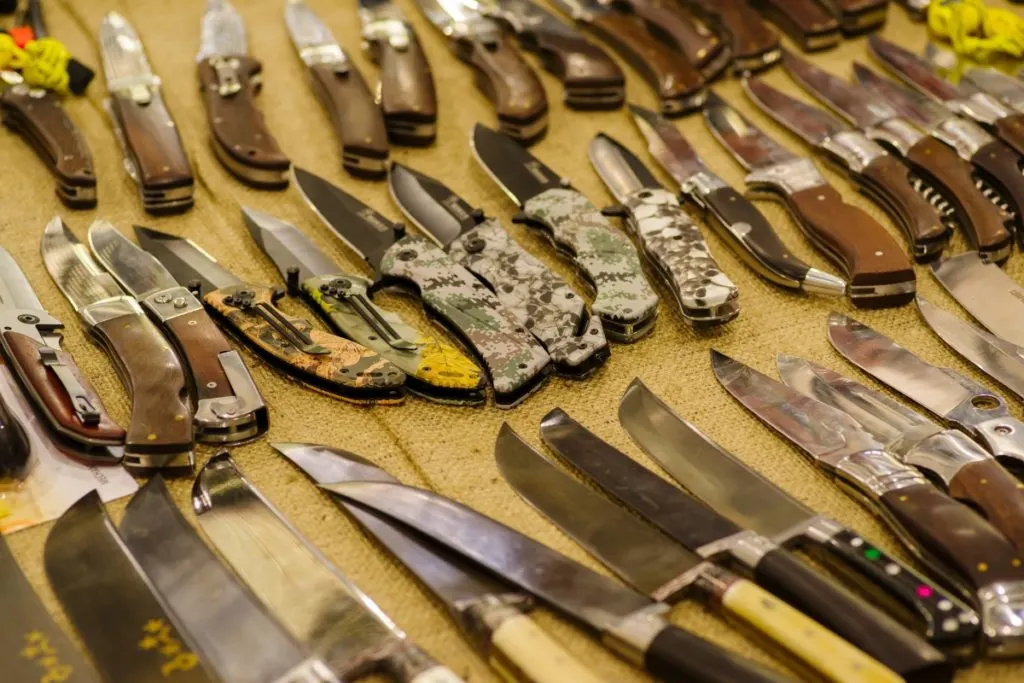
Different knife types need different steels. That’s why we summed up them all in the sections below:
Best Steel For Kitchen (Chef) Knives
The kitchen environment is hot and humid, and the knife will be exposed to acidic ingredients that could damage the steel.
Kitchen knives, and in particular, chef’s knives, are used in a multi-purpose role in the kitchen. This requires robust, wear-resistant, and corrosion-resistant steel to complement the range of tasks the knives are used for.
A high-carbon stainless steel such as VG-10 is the best steel to use for a chef’s knife since it will be stain and wear-resistant with good edge retention and easier sharpening than other stainless steel.
Best Steel for Japanese Knives
Most Japanese knives are built for a specific function in the kitchen. Many of the knives are used for high-precision cuts typical of Japanese cuisine to improve food presentation and flavor.
High carbon steel is the primary steel choice for making Japanese knives because these knives can be hardened to a higher degree. The hardness level allows for the thinner blade for lightness and dexterity, and the steel can be honed to an extremely fine, sharp edge.
The best steel for Japanese knives is Blue Paper steel, or Aogami, as this steel has the best characteristics suited to the function and precision required from these knives. However, these knives are very expensive, making White Paper steel or Shirogami the more common steel used in these knives.
TIP: Check out the complete guide about steels for Japanese knives if you want to know more:
Japanese Knives Steel Types (Complete List with Explanation)
Best Steel For A Hunting Knife
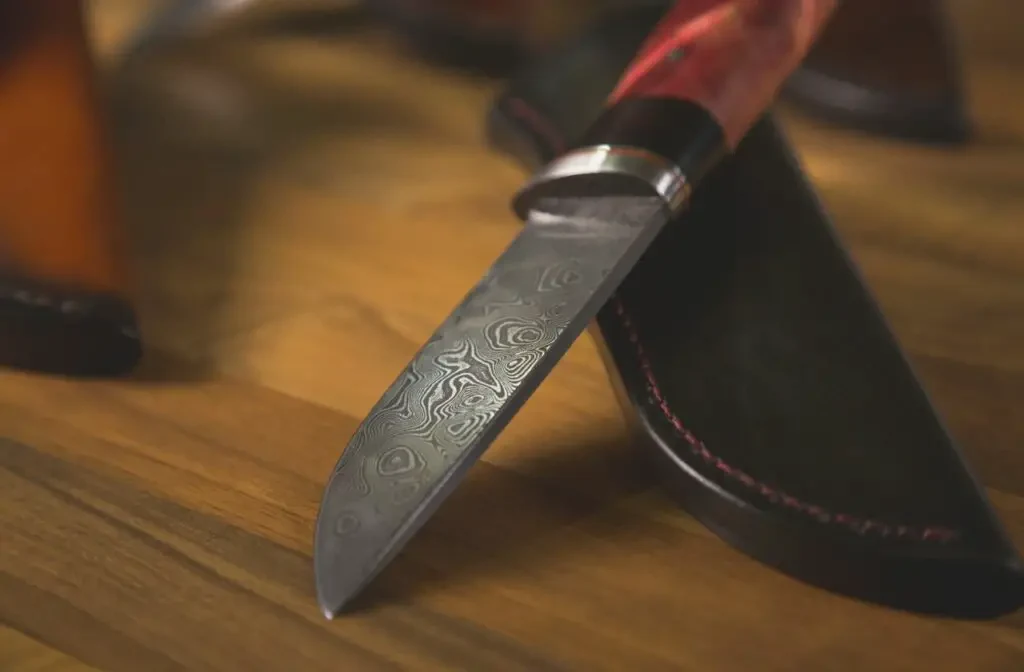
A hunting knife is similar to a bushcraft knife in that it is used for multiple purposes in the wilderness. However, the focus of a hunting knife is for hunting-type activities, such as skinning and processing game carcasses.
This requires knife steel with good edge retention, toughness, and the ability to withstand torsion or twisting motions.
While the choice of steel for a hunting knife is open to personal preference, steel with good edge retention is highly desirable for skinning animals.
80Crv2 is high carbon steel that is tough, shock-resistant, and with excellent edge retention characteristics. These qualities make it a top steel choice for a hunting knife.
Best Steel For Survival (Bushcraft) Knives
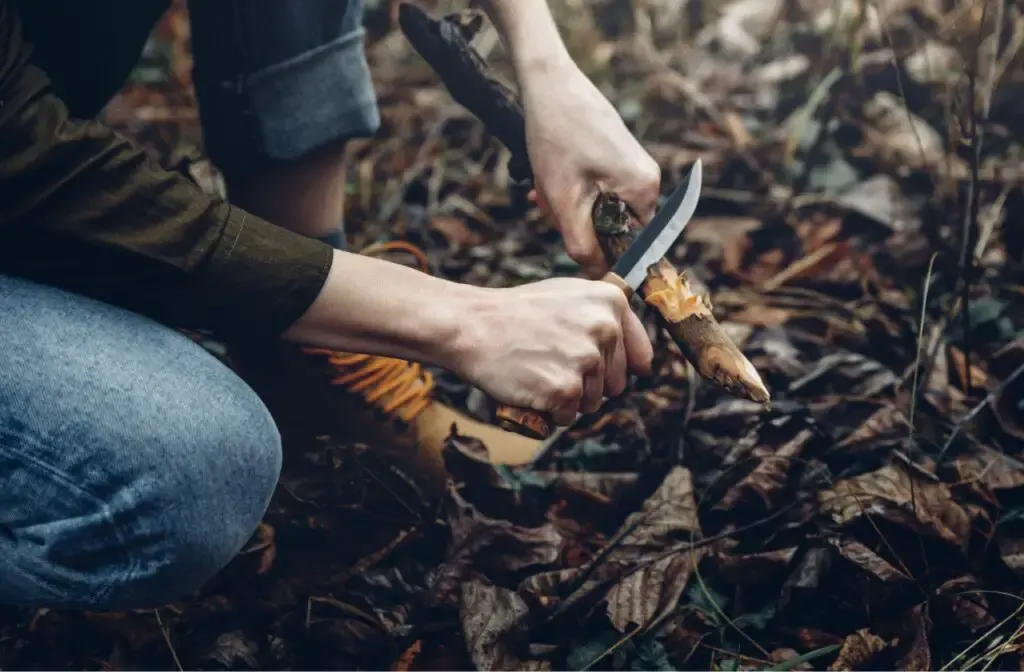
Bushcraft, or survival knives, are required to handle tough environmental conditions and perform well for tasks uncommon for other knife types.
Tool steel and spring steel are generally the better steel types for use in survival knives. These steel types have good impact resistance, hold an edge well, are easy to sharpen, and can handle the rigors of wilderness survival tasks.
Actions such as batoning firewood, which involves bashing your knife blade through a chunk of wood, require robust steel to retain the sharp edge with this type of abuse.
The best steel for a bushcraft or survival knife is O1-Tool steel, or 1095 or D2 as an alternative. Another good steel for this type of knife is 5160 spring steel, which does not is particularly impact resistant and resistant to torsion stresses that would twist and bend other steel.
Best Steel For Pocket (Folding) Knife
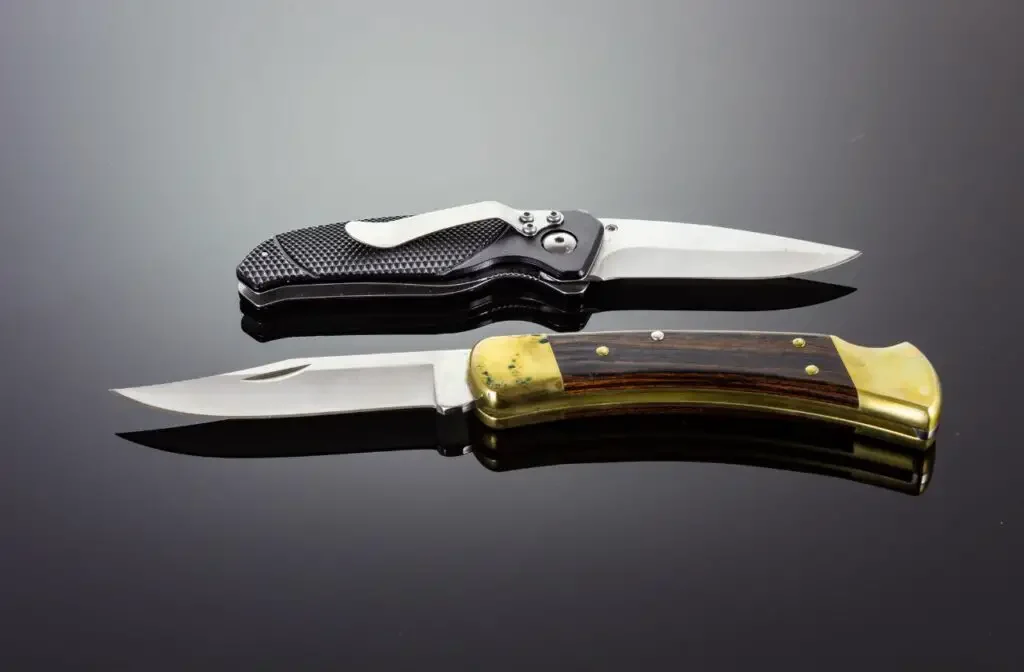
Pocket folding knives are kept in hot, humid conditions in your pocket and tasked with various everyday functions not typical of many other knives.
These knives lead a busy life from cutting rope and twine to peeling an orange, being used ad a screwdriver, or slicing through packing tape and dicing a tomato to go on your sandwich!
Their multifunction use requires steel that would offer the most benefit for these unusual and varied tasks.
The best steel for pocket folding knives is stainless steel, and there are not many in this category that can trump CPM S30V. This steel is top-quality but also expensive, making knives using this steel on the pricey side.
For a slightly cheaper alternative, stainless steel that still offers superb qualities for a folding pocket knife, 154CM is a good second choice.
TIP: Check out the complete guide about steels for pocket knives if you want to know more:
Pocket Knives Blade Steel: The Best One & How To Choose
Best Steel For An EDC Knife
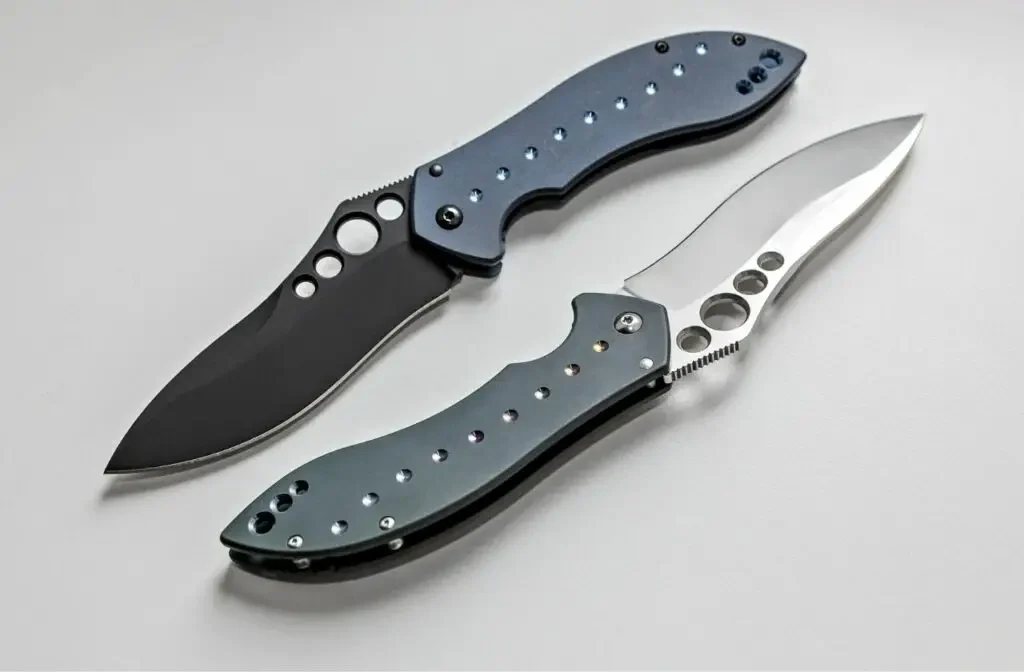
An EDC knife takes on a different meaning for different people, depending on your specific requirements. For some people, a pocket knife is their EDC knife of choice, while for others, a bushcraft or survival knife is the EDC blade. The type of steel best suited for your EDC knife will depend on the type of EDC knife you have.
For a pocket knife as an EDC knife, stainless steel such as CPM S30V is the best choice, while for a bushcraft knife, carbon steel such as O1-Tool steel would make the best choice. These steels provide the reliability and durability required for an EDC blade.
Best Steel For A Bowie Knife
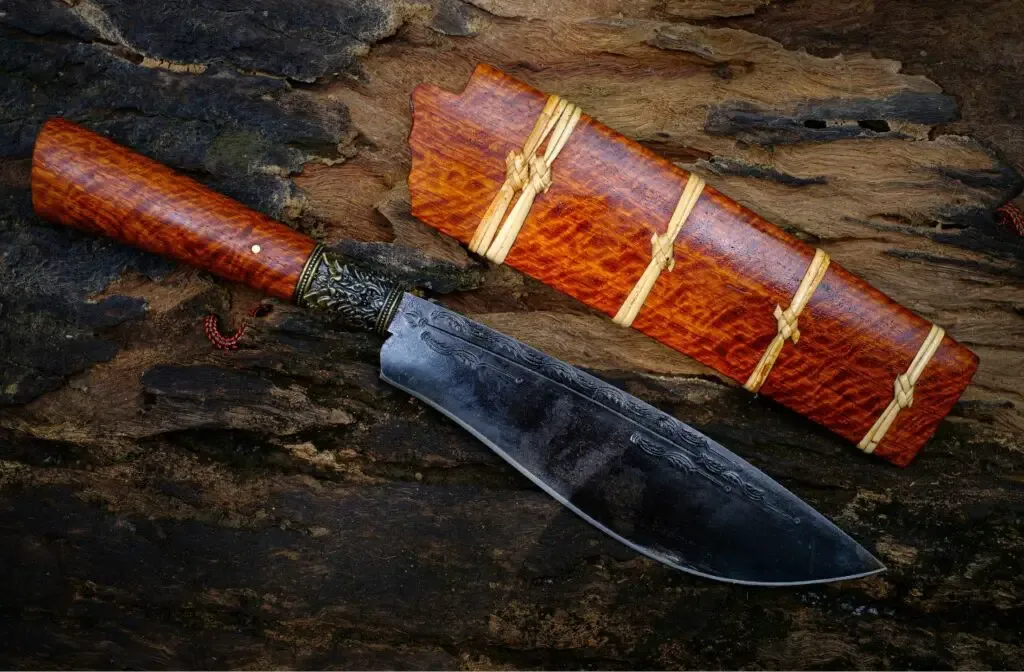
A Bowie knife is basically a survival knife with a large blade. The knife can be used for anything wilderness and survival-related, requiring tough steel that can take an impact but still holds a decent edge.
Tool steel such as CPM 3V is generally considered the best steel for a large blade knife. CPM 3V has high toughness and high resistance to wear, particularly for swords and large knives.
Other good, slightly cheaper alternative steel for a Bowie knife would include 1095, another tool steel, and 5160 spring steel.
Best Steel For A Fillet Knife
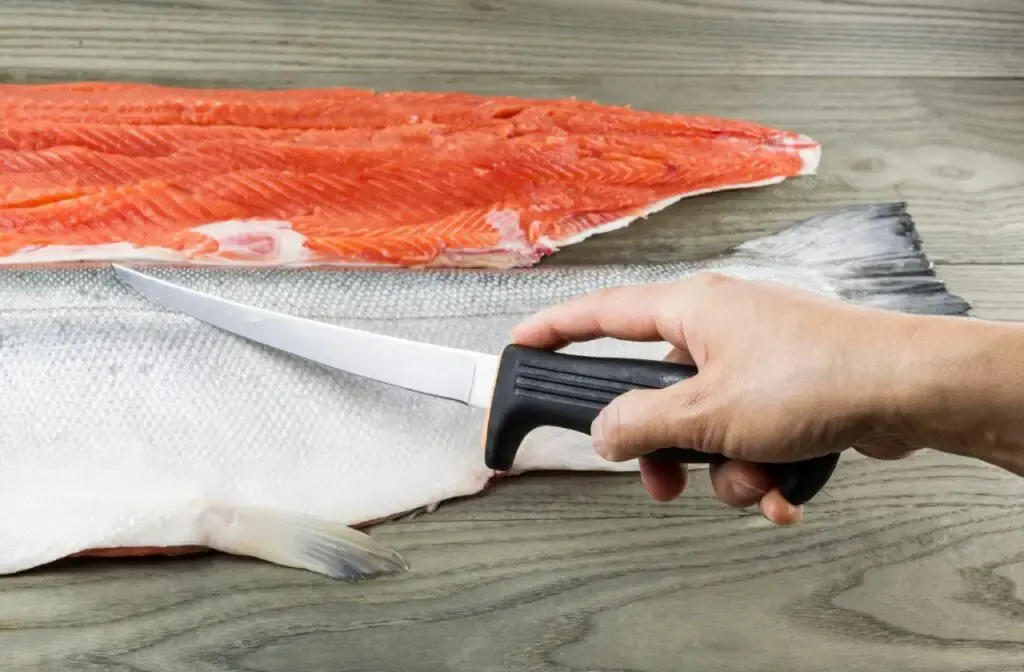
a fillet knife requires extreme sharpness with flexibility in the blade to enable the knife to slice close to the bone to reduce the waste when filleting fish.
The blades are usually thinner than most other knife types to gain the desired flexibility and sharpness. Since the knife is used in a wet environment, corrosion resistance would be a great advantage.
The best steel for a fillet knife that covers the largest number of the requirements for the knife’s function is the stainless steel CPM S30V.
TIP: A common question around the internet is, what is the easiest knife to sharpen? Find out the answer in the article below:
List of The Easiest Knife Steels To Sharpen (With Examples)
FAQs About Knife Steels
Still did not find the answer to your answers about knife steels? Find frequently asked questions in the section below:
What Is The Strongest Metal For A Knife?
Tungsten steel is the strongest metal for a knife, but it is not necessarily the most practical steel for a knife.
Tungsten is extremely strong and durable, and while some knives are made from this steel, it is not popular. The main reason for tungsten’s lack of popularity is the expense of the steel and the difficulty of sharpening the hard blade.
What Is The Most Popular Knife Steel?
While there are many good steel types for making knives, some steel has become more popular than others because they present well-balanced steel at a good price.
The carbon steel 1095 is the most popular steel for knifemaking because it is easy to work and easy to heat treat. The steel also has valuable characteristics, such as good edge retention and ease of sharpening, which make it popular for knife making.
What Is The Sharpest Steel For Knives?
Japanese high carbon steel is the sharpest steel for knives. This steel’s exceptionally high carbon content allows the knife blades to be hardened to an HRC value well above 60HRC.
The high hardness level means these knives can be thin and light, and the cutting edge can be ground extremely thin. A thin edge is a sharp edge, and Japanese steel has the qualities that cater to a thin, sharp edge.
The downside to the hardness is a sacrifice in flexibility, making knives made from Japanese high-carbon steel brittle and subject to cracking and snapping when not used correctly.
TIP: Are you looking to buy a new whetstone? Check out our recommendations (we personally use the first three ones):
Our PRO choice whetstones combo (Amazon links):
- Fixing stone: Whetstone SHAPTON Ceramic KUROMAKU #320
- Sharpening stone: Suehiro CERAX soaking whetstone: Medium #1000
- Finishing stone: Whetstone SHAPTON Ceramic KUROMAKU #5000
Our budget choice (Amazon link): Sharp Pebble Extra Large Sharpening Stone Set
Understanding Knife Steel Properties: A Comparative Guide
When selecting a knife, one of the most critical factors to consider is the type of steel used for the blade. The steel composition not only dictates the knife’s performance but also its longevity and maintenance requirements.
With a myriad of steel types available, each boasting different characteristics, it can be overwhelming to determine which is the best option for your specific needs.
The table below serves as a concise guide to compare and contrast the fundamental properties of various steel types used in knife making.
We’ve outlined key aspects such as hardness, measured on the Rockwell Scale (HRC), which affects the blade’s sharpness and durability; corrosion resistance, indicating the steel’s ability to withstand rust; edge retention, which determines how long the blade maintains its sharpness; and the relative cost, providing insight into the investment required for each steel type.
Whether you’re a culinary enthusiast looking for the perfect chef’s knife or an outdoorsman in search of a reliable survival blade, this table will help you navigate the nuances of knife steels.
By understanding these properties, you can make an informed decision that balances performance with practicality and price.
| Steel Type | Hardness (HRC) | Corrosion Resistance | Edge Retention | Cost | Best Used For |
|---|---|---|---|---|---|
| Japanese Carbon Steel | High (60+ HRC) | Low | High | High | Precision kitchen knives |
| Spring Steel (5160) | Medium (63 HRC max) | Low | Medium | Moderate | Swords, tough knives |
| Tool Steel (O1, D2) | High | Low to Moderate | High | Moderate | Custom knives, durable blades |
| VG-10 | High | High | High | High | Quality kitchen knives |
| 1095 Carbon Steel | High | Low | High | Low | Hardworking knives, katanas |
| CrMoV Stainless Steel | Medium to High | High | Medium | Low | Affordable quality knives |
Note:
Hardness (HRC): Refers to the Rockwell Hardness Scale, which measures how resistant a material is to indentation and wear. Higher numbers indicate harder steel.
Corrosion Resistance: Indicates how well the steel resists rust and corrosion. “High” means the steel contains elements like chromium, which protect against rust.
Edge Retention: Describes how long the blade will stay sharp under use. Steels with high edge retention require less frequent sharpening.
Cost: Reflects the general price range of knives made from each steel type. “High” cost indicates a premium price, while “Low” suggests a more budget-friendly option.
Best Used For: Suggests the most suitable applications for each steel type based on its properties.
Conclusion
The many choices for knife steel give many consumers difficulty when choosing a knife. While it may not be possible to choose a knife made with the best steel due to price and availability, you should always choose a knife made from the best steel you can source and afford.
The more appropriate the steel is for the intended purpose of the knife, the better performance and longevity you will get from the knife!
TIP: There are many different types of knives, each with its own purpose and function, affecting how the edge of the knife will wear. So, how frequently should you sharpen each different kind of knife?
How Often To Sharpen A Knife? (Answers For All Knife Types)
